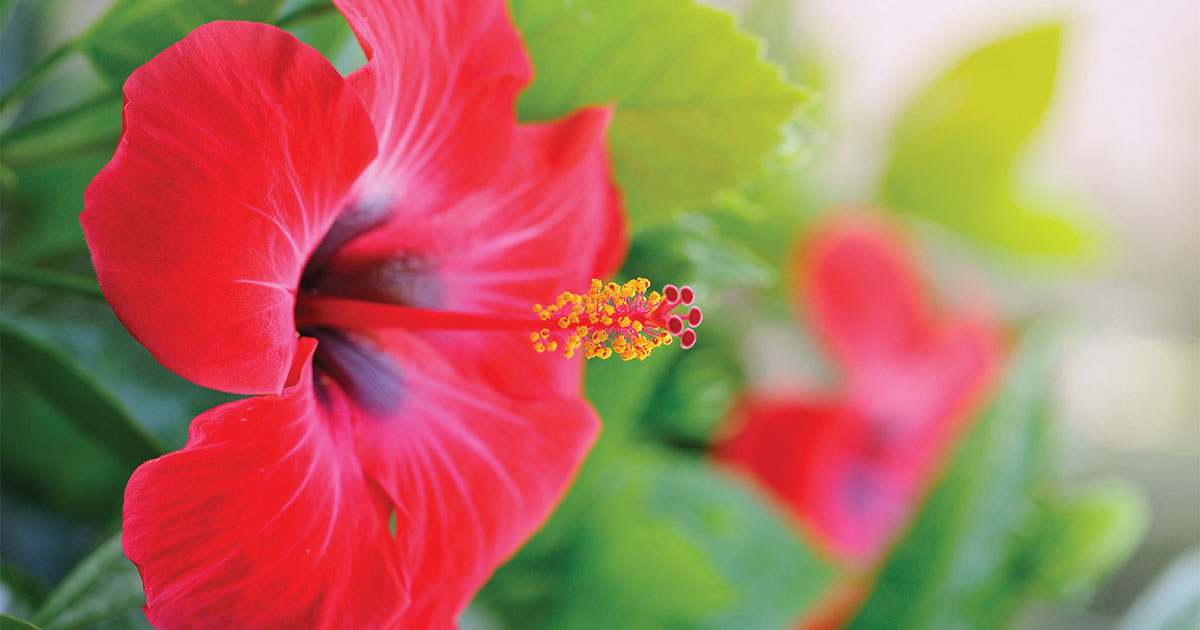
Tropical Hibiscus are a great additional to any garden, constantly rewarding you with big, beautiful blooms through out the spring and summer growing season. Learn how you can keep the blooms coming with tips from Prairie Gardens Plant Experts.
POTTING & PLANTING
When you bring your hibiscus home, it’s important to re-pot it or plant it in the ground. The pots you purchase them in are often too small and, thus, can only hold so much water. Replanting it will allow it to get and retain the moisture it needs to flourish.
In a container: Hibiscus do prefer to have their roots crowded a little, so choose a container that is a little bigger than it’s original pot rather than much bigger. Also make sure you container has holes, so excess water can escape out of the bottom. It’s best to repot your hibiscus using a well-drained potting mix for best soil retention and good drainage.
In the ground: When planting, make sure to loosen up the soil and create a hole about twice as wide as your pot and about the same depth as your pot. Remove your Hibiscus plant from its container and loosen the roots at the bottom. If you soil is very compact, consider adding some compost to loosen it up.
SUNLIGHT
Hibiscus plants are tropical annuals, so they prefer large amounts of sun. Make sure to plant or place your Hibiscus in a spot that will receive at least 6 hours of full, direct sun daily.
WATERING
Hibiscus Plants prefer lots of water. They’ll need the most amount of watering during the blooming stage in spring in summer. During warm periods, you’ll likely need to water daily. During hot, humid periods you may even need to water a couple times a day, depending on if your Hibiscus is in a container or in the ground (containers require more frequent watering).
Although Hibiscus plants need lots of water, you should still be careful to not overwater them. Before you water, just stick your finger into the soil about an inch to two inches. If the soil is dry or just slightly moist, it’s time to water. If the soil is wet, wait to water. Hibiscus prefer to remain moist, but not wet, and they do not like to dry out too much in between waterings.
FERTILIZING
Why you should do it: It promotes more beautiful blooms and encourages healthy new growth!
When you should do it: During the blooming period in spring and summer is the best time to fertilize your Hibiscus Plants.
What you should use: You can use a Miracle Grow slow-release fertilizer or liquid fertilizer…just follow the package instructions!
PRUNING / DEADHEADING
Hibiscus Plants do not require much pruning or deadheading. Just remove damaged, broken, or yellow foliage as you see them. Although spent blooms will drop on their own, plucking them off as they fade will encourage quicker new growth. The spent blooms will come right off with your hands, similar to petunias, but you can use pruning shears if you prefer.
TEMPERATURE
Hibiscus plants do best in temperatures between 60-90 F and cannot be outside if temperatures are going to reach below 32 F. If temps are going to get below 32 F, make sure to bring your Hibiscus plants inside until it warms up.
OVERWINTERING
Tropical Hibiscus plants are annuals in our Midwest area, and will not survive temperatures below 32 F. You can bring your Hibiscus plants inside once the weather gets cooler, however, and overwinter them.
While inside, your Hibiscus plant will need less water and no fertilizing. Place them by a bright window and away from drafts or vents. You’ll find your Hibiscus will bloom less inside, or not at all, but once spring and summer come again, so will the blooms.
COMMON PROBLEM: YELLOW LEAVES
One of the most common Hibiscus questions we get is: why is it getting yellow leaves?? Often times, it’s a pretty simple issue your Hibiscus plant can easily bounce back from. Common causes below!
Small environmental changes: Tropicals are sensitive and will react to environmental changes. Fluctuations in the weather, switching between having them inside and outside, or even re-potting them can cause your Hibiscus to get a little stressed. But it’s nothing much to worry about, they’ll recover quickly once they get a little more consistency.
Poor Drainage or Circulation: Both bad drainage or poor circulation can cause your Hibiscus plant to become stressed. Make sure your Hibiscus has enough space around it for proper air flow and is also in a soil that allows proper drainage.
Improper fertilization: You may be over-fertilizing. Make sure you are fertilizing your Hibiscus frequently, but lightly. Check the back of your fertilizer to make sure you are following directions.
Improper Watering: Unfortunately, over watering and under watering can both lead to yellow leaves, so it can be hard to pin-point which it is. Hibiscus do like lots of water, but they do not like to sit in soil that is constantly wet. If the soil is already wet, wait to water. If it is just slightly moist, this is when you should water again. Anytime your hibiscus shows signs of suffering from dehydration, dropping leaves, bone dry soil…this is causing stress and affects the health of your plant. Make sure you are watering consistently.




